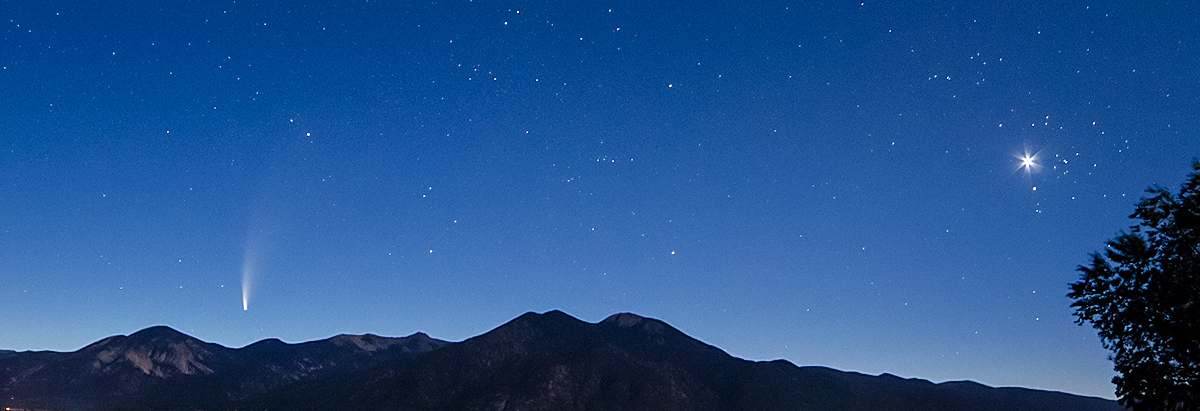Personal Update -- late November, 2021
I was invited to attend a nice Thanksgiving dinner with new friends David and Heather. During the "event" Heather took an unsuspected portrait with her new Canon rig -- see below. I guess I am a storyteller at heart.
Additional Update -- November 19, 2021
This morning at about 02:10 A.M. local Mountain Standard time, I got up and wandered outside to view the eclipsing Moon. It turned out to be a glorious sight, even though the Moon was only deeply partially eclipsed; ~95-98% . The eclipsed side of the Moon was visible as a deep ruddy, yellowish color and the non-eclipsed part was just a thin crescent of white. As always, what is spectacular about a total eclipse of the Moon (and this one, too, as it turned out) is that during the total (or near-total) stage(s) the Moon's bright light dims and many stars "come out" or reappear. A difference here was that the "near-totality" was instantaneous -- generally the Moon stays in the full projected shadow of Earth (the umbra) for quite a long time, perhaps and hour or more. This morning, the moon was in Taurus, alongside Orion -- all the stars of those constellations "came out" and even the Great Nebula in Orion (imaged here, and previously) was visible. Quite a sight. Soon however, since I went out with virtually no clothes on, I had to retreat back into the house.
Update -- November, 2021
For much of the summer and fall, and when I have been in town, I have concentrated on updating Rabbit Valley Observatory by reinstalling the excellent Celestron CGX automated go-to German Equatorial mount on the exterior pier (previously installed and pictured to the right and below on this page), installing this time a visual/photographic10-inch f/4 GSO rich-fleld reflecting telescope on it, and then completing the installation by building a rolling shed to cover the instrument. I chose a KETER Manor 4x6 Resin Outdoor Storage Shed, as pictured below with the original domed unit.
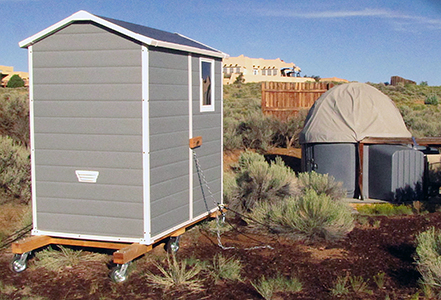
I built and then modified it by cutting a slot in the floor, thereby allowing the shed to roll off off and out of the way on the pier-mounted telescope, as below, left.
Once the building is rolled off (note security chains to hold it in position during storms and high winds, the CGX-mounted 'scope is revealed, as below.
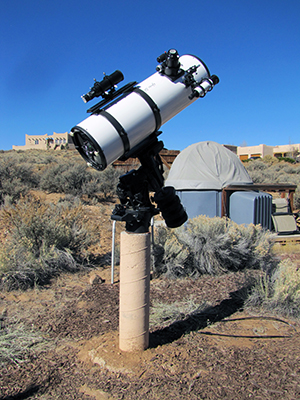
Below is close-up of the finished unit, with electric hook-up pole in the background.
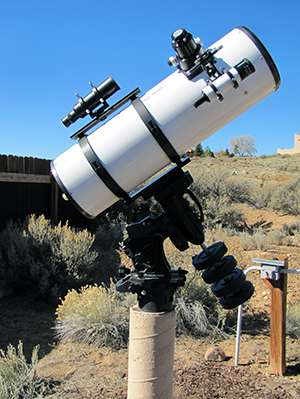
The 'scope is equipped with a Rigel electric focuser attached to the excellent stock GSO 3-inch focuser, two finders, and an Astromania 60mm photographic guide 'scope. I intend to use this 10-inch 'scope for both visual and (especially) video astronomy for visitors, and hopefully wow them with the automated features of the go-to mount and sensitivity and auto-stacking capabilities of the Atik Infinity video camera.
Important Update -- September, 2021
The Taos Astronomer will be out of town and unavailable during the entire month of September. After that, I anticipate clear autumn days and dark productive nights. Thanks for your patience -- see you this autumn/winter!
Update -- July 8, 2021 -- observing session with Monte and Mara
Given the typical smoke in the sky summers here, I was not too hopeful that the Milky Way (something either person had seen, ever(!). We decided to take our chances on their second (and final) night/morning here, Thursday, July 8, 2021. I suggested they get here about 12:30 AM, so Sagittarius was on the meridian. It was wonderfully clear and transparent.
We sat out in chairs for about ½ hour to get our eyes acclimated, and the Milky Way was obvious; I pointed out some constellations and two dark rifts in the Milky Way, both clearly visible.
We then opened up the observatory, and observed the following objects:
Jupiter
Saturn
After initializing the DSCs (one star), I then concentrated on DSOs, including:
M11
M22
M8
M17
M57
M13
And others. We generally used the excellent but no longer available 32mm University Optics eyepiece, but did go up to the 13mm for higher power views of the planets and tight clusters (and M57, of course). The DSCs performed excellently –- all objects directly in the field of view, and generally centered, which was good, especially since the new finder arrangement was not set up well. I did that the next morning. The cover fabric also worked very well – no leaks whatsoever.
Note -- I prefer the laser pointer both for getting the telescope very near the target, and also hand-held to point out constellations, etc.
Another note –- I did not slide the dome back, hence we concentrated only on objects in the southern sky, with few exceptions. This is sub-optimal, but, this time around, fine, as there were many objects to choose from in the south.
We packed up about 3:30 AM
Update -- December/January, 2021
Every year, I send out, both by snail-mail and linked digitally of course, our Christmas/Holiday greeting. This year's version, including photographs of seven comets (and one meteor shower), concerns my long personal history vis-a-vis such celestial visitors and is entitled "A Half-Century of Comets," linked here for your enjoyment. It is embedded in an otherwise undisclosed location within this website! Enjoy!
Update -- December 22, 2020
Last evening, I enjoyed entertaining several guests, who came over to view the conjunction (Jupiter and Saturn), appearing low in the western sky just after sunset. As a bonus, we also looked through my original and classic Celestron-Pacific C-8 (that's Cheryl and I standing with that very C-8 in Zimbabwe, 2001) at the moon. We observed from our side porch up on the mesa west of Taos, NM.
Neighbor Leslie R. and her two children attended, along with her visiting brother, partner, and their children. We all wore masks, but I advised the observers to remove their face covering while looking through the eyepiece to ward off any "steaming up" of the optic.
Two of the children were "old enough" to look through the telescope and ascertain the resultant image's details. I had them climb a ladder, warning them not to touch the telescope -- "It might move or fall over" -- and then look through the superb 32mm classic Konig eyepiece from University Optics. I have a complete set (1¼ and 2-inch), with some duplicates for use out in the observatory as well.
I have found that children are far more honest and straightforward than most adults with this process, either saying "I don't see anything" or "I see the holes in the Moon" or whatever. Both kids that looked through the scope (first and second-grade children) described the view perfectly and answered some questions, like "Which one is Saturn?" "The upper one. " "Do you see the rings around Saturn?" With awe, of course -- "Yes!" "What do you see beside Jupiter?" "Little stars in a row." "Those are its moons, its satellites." "OK." "Is that one really far away but lined up a moon?" "Yes, of Jupiter." "How about that other one, way far away?" "I don't know." (It turns out, accessing the diagram below -- yes, it was a distant moon of Saturn.)
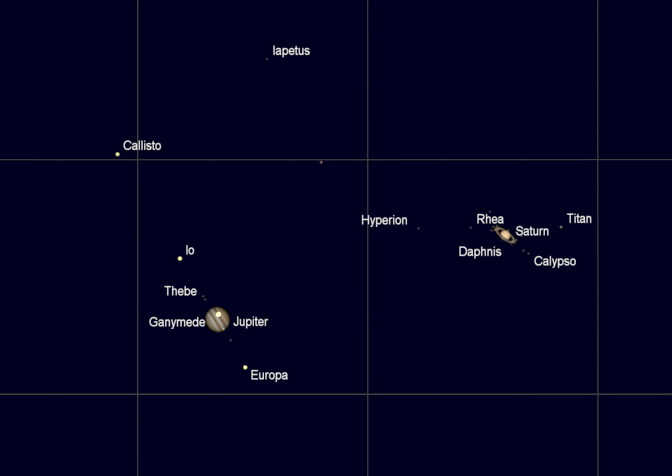
Chart from free Planetarium program Cartes du Ciel -- linked here
I discussed the notion that Jupiter has no solid surface, sort of like jello, but I also used the word viscous -- "hey, what's wrong with learning a new word" -- but its moons do have a solid surface. "And maybe someday we could land on one of those moons and look for signs of life."
Below is an image world-renowned astrophotographer Adam Block obtained; I'm re-posting it here © Adam Block, all rights reserved. Note that due to our telescopes' differing configurations, his image appears slightly different in perspective. Telescope's optics reverse the image, plus various photographic configurations often flip the image again. That's why this image is a bit different -- the sky chart above accurately depicts our scene with our configuration -- Mr. Block's image accurately depicts how the individual planets and their moons looked through the eyepiece.
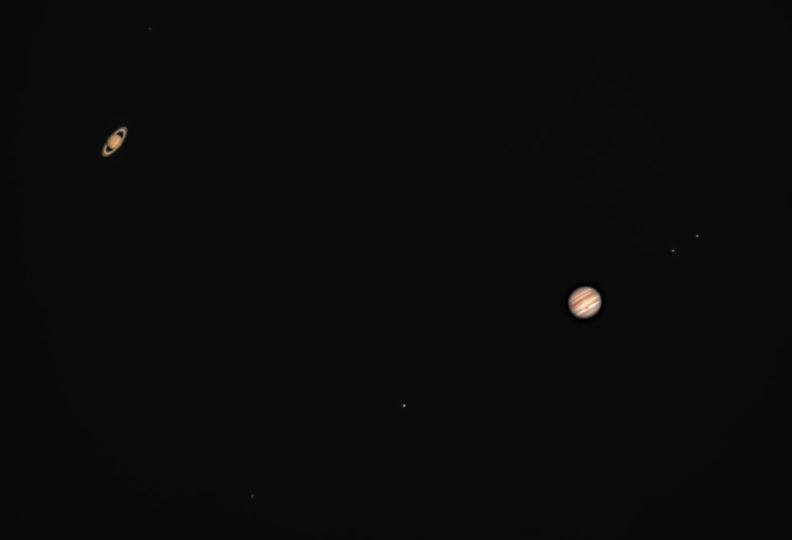
I once took an all-night astrophotography class on Kitt Peak in Arizona with Adam Block -- the course featured only Mr. Block and me for the entire night. It was a wonderful gift from my wife, Cheryl, who did assist with the image gathering. Pretty much I watched and did what he asked -- he has grown to be one of the most significant and respected astrophotographers in the world.
So all of our guests, Cheryl, and I viewed the scene telescopically -- the beautiful alignment. Like most of you reading this, I "just" consider this a beautiful and rare phenomenon, not some positive omen (although we could use one!) or possessing some profound spiritual or religious meaning.
I believe that the heavens -- the night sky –- are quite magnificent all by themselves. There is no need to trump up "this year's only blue moon on October 23" or other such nonsense. This event was just a beautiful thing! I hope you saw it, too. Happy Holidays!
Update -- November 12, 2020
Recently I have had several communications with potential visitors. Due to the continuing pandemic and fears of Covid-19, and as previously noted, we really aren't having any RVO observing nights at the moment. Some groups did choose to cancel or delay their visit as well. Hopefully, things will "normalize" soon.
There have been two visitors of note, however, a fellow astrophotographer from Florida and his partner and co-astrophotographer Heather. David, as well as being a wonderful budding astrophotographer, also was a significant member of a very well-known southern rock band early-on, and continues creating and playing to this day, albeit mostly now classical musical forms.
During their real-estate centric visit, they DID decide to purchase a home out near the very small, regional airport. Their new home is also "conveniently" located only 2-3 miles from our place! This area offers unfettered horizons and, other than one pesky but avoidable rotating tower light, is virtually dark at night. I met them out there last night and gave my tacit approval (who cares, right?) of their new seasonal home.
Attached within the our digital communications was one of David's and Heather's efforts, an outstanding photograph of M31, the Andromeda Galaxy. I'll post it below, © David & Heather, all rights reserved. Also, I will take the liberty of naming it and concurrently paying homage to what turns out to be both my and Davids' all-time favorite Star Trek episode, TNG's "Darmok," review linked below. I am naming the galaxy shot below "David and Heather at Night." (Editor's note -- watch the episode!) Literary comment on this significant episode linked here . . .
https://www.theatlantic.com/entertainment/archive/2014/06/star-trek-tng-and-the-limits-of-language-shaka-when-the-walls-fell/372107/
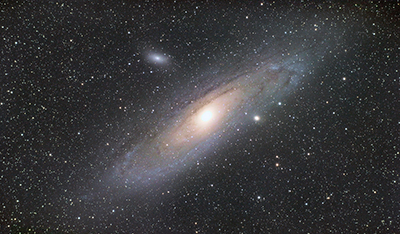
Isn't their image magnificent? They used for this effort an unmodded recent CanonEOS and for post-processing the Mac-based software AstroPixelProcessor, link below . . .
https://www.astropixelprocessor.com
I look very forward to their moving here and learning and growing with their experiences! Hey, they even put up with my non-stop storytelling.
As a point of reference and comparison, recently I have been using the superb Astrophotography Tool (APT) for image acquisition at the telescope. One of its really excellent routines is the Bahtinov Aid Grabber focusing tool and routine -- here's the link to that very modestly-priced program . . .

I'll conclude with this mind-blowing, brilliant scene from "Darmok" --
https://youtu.be/ANvlLcOTy6M
One more -- the ending of the other really, really outstanding episode, "The Inner Light" . . .
https://www.youtube.com/watch?v=RQKp27ZDuCk
And, just a reminder -- Comet NEOWISE -- please click on this text.
Additional Final Update -- July 28, 2020 -- Comet NEOWISE
I sought out and viewed the comet last night about 10 P.M. local MDT, only with binocs and with difficulty. It is clearly much dimmer and displayed much less tail; further, the bright quarter Moon brightened up the sky considerably. I think that will be the last I see of this spectacular comet.
On another note, in one of my previous logs I mention the difficulty of getting a clean astrophotograph of the comet without a Starlink satellite streak. Linked here is some additional detail.
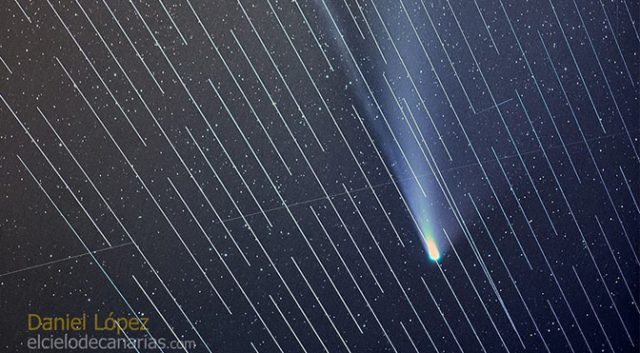
I saw these satellites moving through (shown on the above time exposure and as explained in the linked article), as well as the ISS streak ~90 degrees to the Starlink satellites. This issue, I conclude, is a real problem with large consequences.
Yes, the photographs presented here are "merely" from hobbyists, but professional astronomers doing "real" research have been bombarded with such outrages as well. And, at this point in time, only a small percentage of such satellites have been put into orbit.
Final Update -- July 23-27, 2020 -- Comet NEOWISE
Last Thursday, July 23, I am excited to report that the local newspaper published two of my Comet NEOWISE photos, along with an article containing some of my observing notes. Please access the article by clicking this text.
In the last week, after the spectacular viewing of the night of July 20, it has been very cloudy and rainy (rare for here!) and so I have concluded that, given the weather pattern and the encroachment of an ever-expanding moon phase, we are likely not to see the comet again.
But why have so many people been unable to see the comet at all, even though seasoned observers have not had a problem; especially considering that this comet is considered to be the brightest and most observable since Comet Hale-Bopp. This article on the ever-increasing specter of light pollution, linked by clicking on the image below, may clear that up. Here's the salient point:
"Comet NEOWISE has turned out to be the most photogenic since Comet Hale-Bopp in 1997, but if you’re having trouble finding it with your naked eyes, you’re not alone.
No matter how many star-charts you consult, finding this icy visitor from the outer Solar System is not as easy as it should be.
Is it your eyes? Is it you not knowing exactly where to look?
No -- it’s light pollution where you live, which is likely increasing each year.
That makes the once-in-a-decade appearance of a bright comet a big moment; it could be your first, and possibly your last, chance to see a comet with the unaided eye."
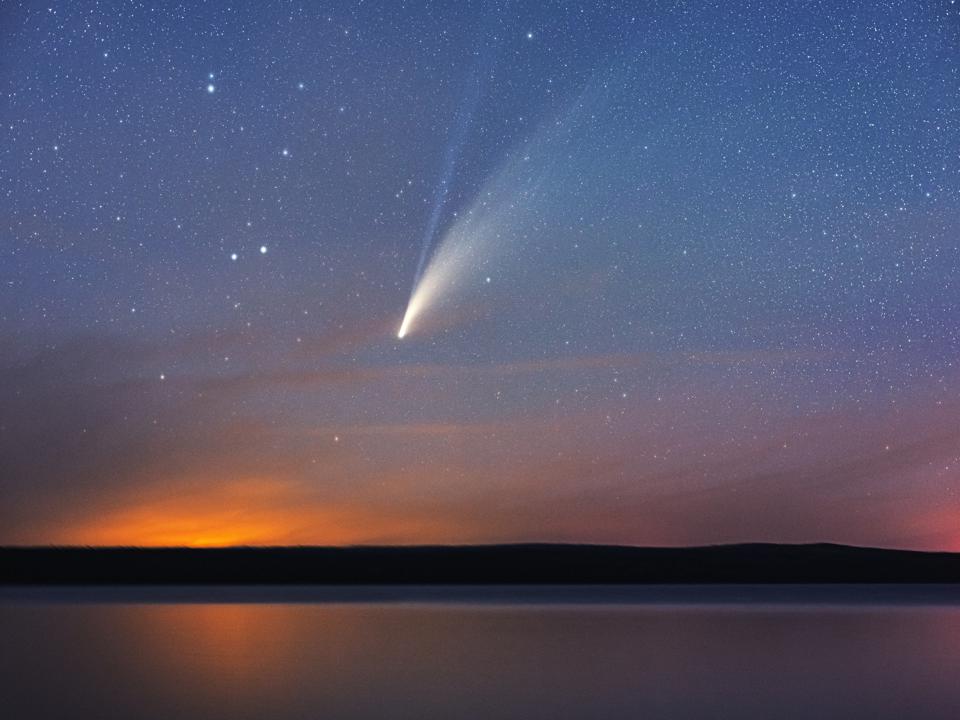
Update -- July 20/21, 2020 -- Comet NEOWISE
Updated "final" (nothing is ever final) images of Comet NEOWISE, linked here.
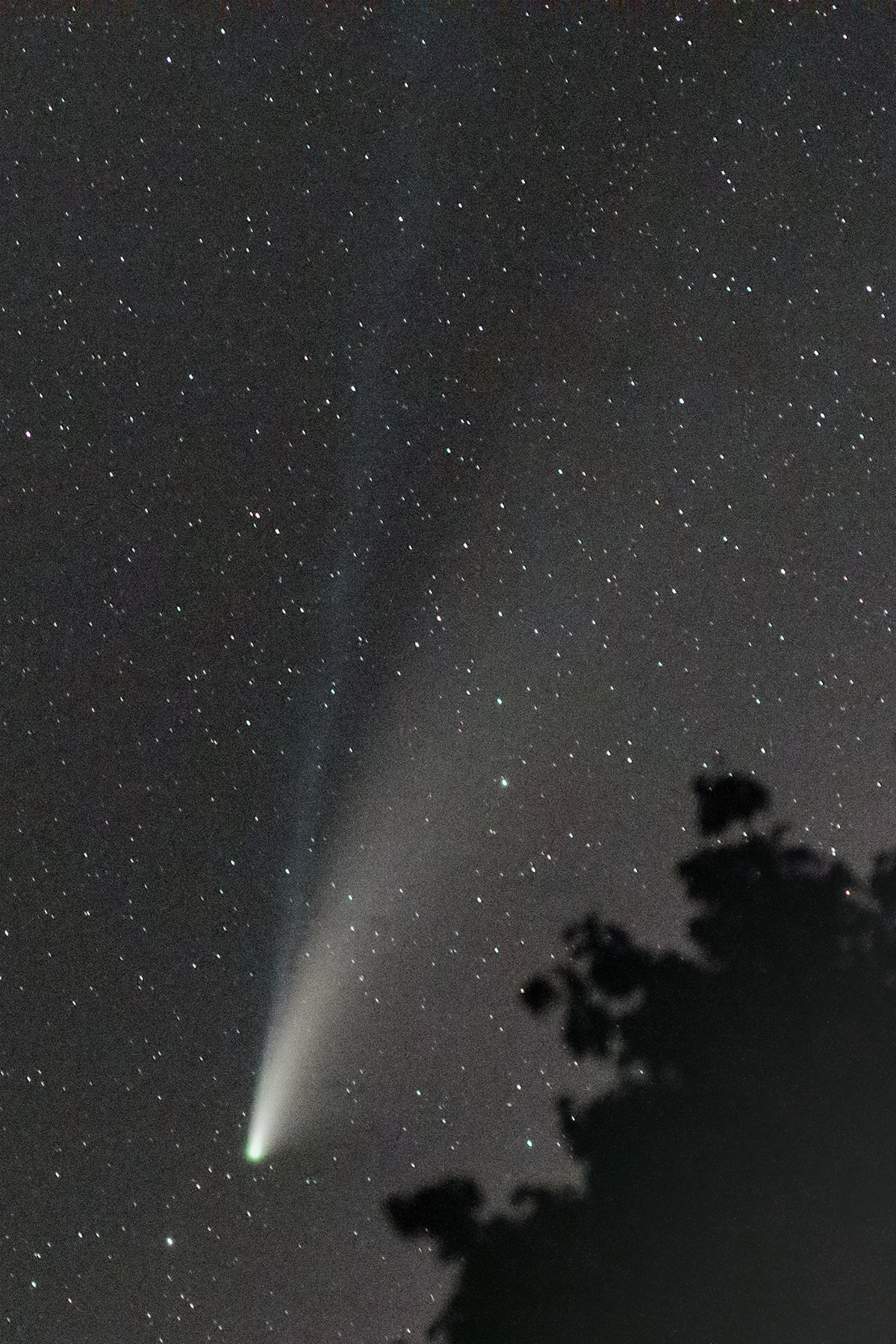
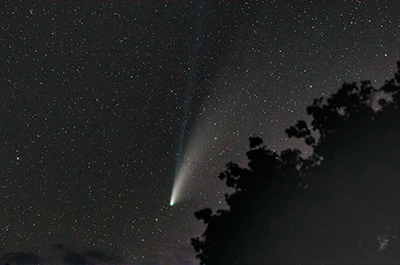
First clear sky since 7/12/20; went up on the mesa, set up white iOptron SkyGuider Tracking EQ mount, reviewed polar alignment instructions (using cell ‘phone’s GPS to determine Polaris’ location on the polar finder’s reticle) and waited. I had determined that an 85mm lens (mounted on the ball head) would be just about right, given the recent photographs published on the web, and considering a rough estimate of the size of the comet’s tail. I focused to infinity — always required for astrophotography and slightly to the right of this lens’ preset mark — on a distant airport light, and waited. Although waiting for nightfall and a glimpse of the comet was a very calming exercise, nevertheless as it got darker, a huge cloud started to obstruct the northern sky. So, after much planning and waiting, I finally gave up, about 21:30 MDT and drove the short distance home (5 minutes).
Upon arriving back home, those clouds had already started clearing out, so I unloaded and viewed with the Pentax XCF 12X50 binocs (FOV is 5.6 degrees). And, perhaps about 22:00 MDT it did clear up, and the beautiful Comet NEOWISE was fully exposed. Visually, you could just make out the comet’s ion tail as well as a very obvious, even with the naked eye, its dust tail. Estimated (difficult for such an extended object) magnitude was 1.5. After 20 minutes or so of viewing, the sky remained clear; so I decided to take a few non-guided “snapshots” of the comet. I put the ball head on the regular tripod and composed the pics, best one as pictured here. I set the exposure time for 8 seconds (500 rule suggests 4 seconds to avoid star streaking with this config), guessing (slightly incorrectly) that any longer would show too many star trails on an unguided platform. To compensate, I set the ISO at a noisy 6400, and shot one stop down at f/2.8. As the comet started to set, clouds also reappeared, but frankly I think I was lucky to see and photograph it at all! One additional notation — there was a constant barrage of satellites “flowing” through the field of view, essentially ruining many of my photographs. Some observers and photographers have previously noted that “they” were the ISS, but there were quite a few, suggesting the new barrage of communications satellites recently put into orbit.
Concluding, visually the comet was at least 6 degrees long, ion tail barely visible to the naked eye, yellow/whitish dust tail obvious, long, and spread out.
Specific data below:
Comet NEOWISE below pointer stars of the Big Dipper, taken on a fixed tripod from our back “yard.” (Nikon 5100, Nikon 85mm f/2 lens, F/2.8, ISO 6400, 8 seconds, 22:24 MDT, 07/20/2020)
Updated "final" (nothing is ever final) images of Comet NEOWISE, linked here.
Update -- July 13, 2020 -- Comet NEOWISE
Cloudy this morning, so I updated this website to include my "final" (nothing is ever final) images of Comet NEOWISE, linked here.
Update -- July 12, 2020 -- Comet NEOWISE
Mountain horizon generally clear, comet rising to the left (north) of previous location and clearing the local mountains between 4:15 and 4:20 MDT. My 10X50 binoculars have a field of view of 7 degrees. The comet extends over at least 1/2 of the FOV, or 3.5 degrees in length. I would say that the length is a bit more than that, perhaps then 4 to 4 1/2 degrees long. The head is still quite tight, star-like and bright (as Capella in Auriga), the tail relatively unchanged other than its rotational pivot away from the sun.
Update -- July 11, 2020 -- Comet NEOWISE
A little after 4:00 this morning the comet cleared the mountain ridge skyline as seen in the previous adjacent photographs. The sky was hazy and a bit cloudy (for here) so I decided to not attempt any photographs. I did notice that the comet's tail was starting to "tip" a bit northward, an indication of it turning as it pivots around the sun. It will appear in the evening sky in a little over a week. It was easily visible to the naked eye. As to nomenclature, the comet's name, technically C/2020 F3 NEOWISE comes from its discoverer -- the satellite NearEarthObjectWide-fieldInfraredSurveyExplorer -- C indicates a comet, 2020 the year of discovery, and F3 indicates that it was discovered the second week of March. I prefer the "old" comets -- the ones that carry the human discoverer's name(s) like Halley and Hale-Bopp, or Comet Hyakutake, named after its intrepid and patient Japanese discoverer Yuji Hyakutake, who has discovered several comets.
Update -- July 10, 2020 -- Comet NEOWISE
As you can likely surmise by noting this website's new logo image above, I was able to solve the focus problems (employing a different manual-focus lens -- the Rokinon 14mm f/2.8 ED, using LiveView on the Nikon 5100 to focus carefully on Venus and the Hyades star field, and stopping down the lens a bit) -- the excellent results are below . . .
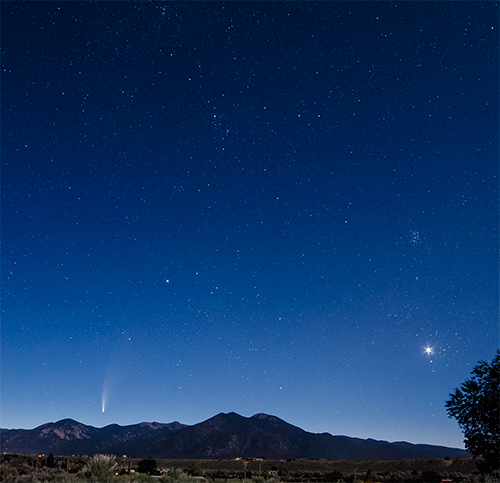
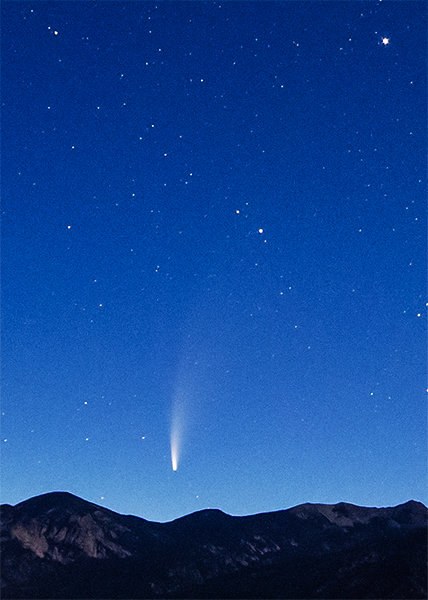
Data on the above photographs -- top image -- Comet NEOWISE, Auriga rising just above comet, Venus in the Hyades to the right, Pleiades above. Foreground is west of Taos, NM on the mesa, large double mountain is Taos Mountain, the sacred mountain of the Pueblo people. More distant pointed Wheeler Peak (tallest in NM) to the left of Taos Mountain. The close-up vertical shot is merely a crop of the horizontal image, first-magnitude star Capella in Auriga top right in the pic. Taken on a fixed tripod from our front porch. (F/4, ISO 3200, 15 seconds, 04:35 MDT, 07/10/2020)
Update -- July 9, 2020 -- Comet NEOWISE
After viewing the comet for two straight days, I felt it was time to image it. I dutifully looked at star charts and decided that the best and most artistic framing would be to include the local mountains and the adjacent lovely star field. I awoke at 04:00 MDT and set up just outside our front door. I employed a manual-focus wide-angle fast Samyang 16mm f/2 lens on the Nikon 5100. I didn't get the focus quite right (no auto-focus here -- it must be manually focused, difficult in the dark), although I'm relatively happy with the result. Tomorrow morning I'll attempt to improve my efforts, which might allow me to enlarge and crop the resultant photo. I do very much like the resultant field-of-view.
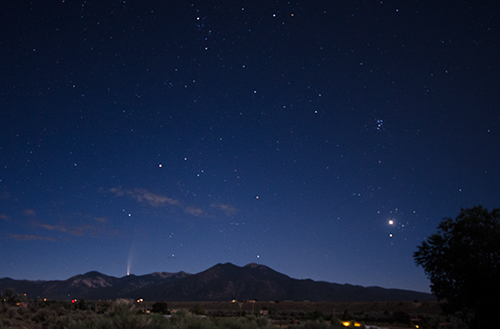
Data on the above photograph -- Comet NEOWISE, Auriga rising just above, Venus in the Hyades, Pleiades above. Foreground is west of Taos, NM on the mesa, large double mountain is Taos Mountain, the sacred mountain of the Pueblo people. More distant pointed Wheeler Peak (tallest in NM) to the left of Taos Mountain. Taken from our front porch. (F/2, ISO 1600, 4 seconds, 04:28 MDT, 07/09/2020)
Update -- July 7, 2020 -- Comet NEOWISE
This morning, about 04:45 MDT, my wife Cheryl spotted this comet above Wheeler Peak, east and slightly north of our location just west of Taos, NM. We both viewed it through 10X50 binocs -- it took up about 1/4 of the FOV (Field of View), and Cheryl DID see it with the unaided eye as well. It was perhaps first magnitude, although since the sky was starting to brighten, this was difficult to judge. Below I will link to an informational website, as this comet promises to get brighter, especially as it moves to the evening sky later in July. But for now, try locating it in the northeast sky before dawn. Beautiful!
https://www.space.com/comet-neowise-july-2020-night-sky-forecast.html
Below is a photo taken on the morning of July 5, 2020 from Lebanon © Maroun Habib -- this image very similar to our view through binoculars.
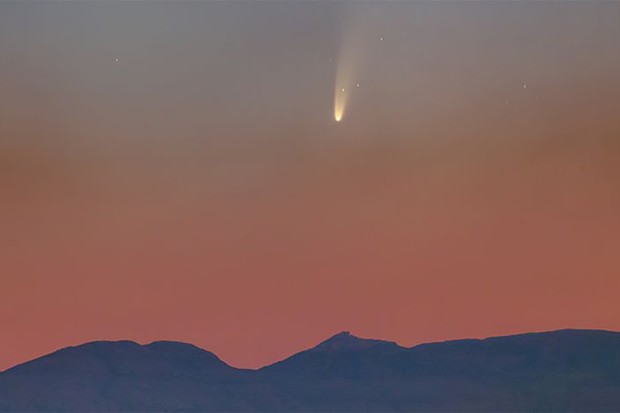
. . . and a shot from the Mojave Desert in California, © Daniel S. Perry, July 7, 2020, 05:27 PDT.
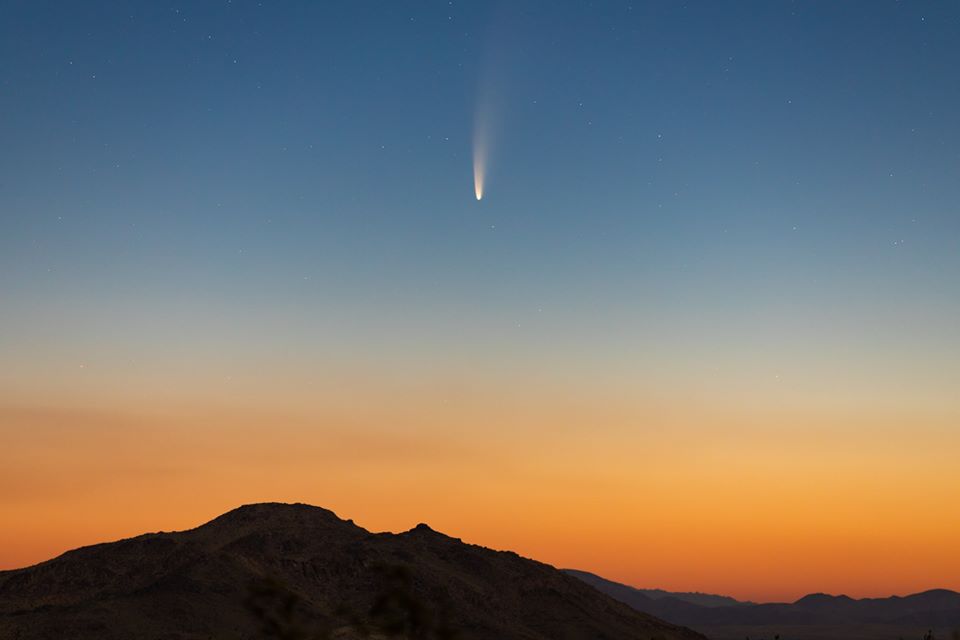
Update -- July 4, 2020
I have returned from a (rather annual) San Juan River float trip; seven days and six nights through the remote Goosenecks in southwestern Utah -- immersed deep in a canyon adjacent to Monument Valley. Astronomical reports include (often) waking up in the middle of the night to a magnificent, star and Milky Way-studded dark night sky. (I sleep under the stars as long as the weather is OK. Nights were very warm.) One night I awoke and remarkably viewed a brighter-than-first-magnitude object "streak" (more like "creep") slowly across the entire sky! Originally I thought it to be a very amazing meteor (albeit too slow and too long, I felt), but, after returning I learned that it was very likely an asteroid, per the below-linked article.
https://abc11.com/asteroid-green-fireball-australia-nasa/6248723/
The movie shown on the news clip seemed to reveal an object much like what I saw, plus it was the correct date.
An event like this just proves once again that the simple act of sleeping out under a dark sky can result in some momentous sightings!

Humor update -- May 1, 2020
There's a community very near where I once lived in Colorado, west of Denver in the foothills. They offer humor (generally puns) on their billboard, and recently there was one of an astronomical theme.
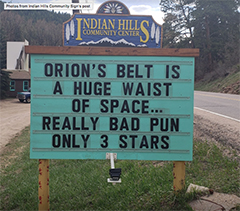
Observing schedule for Spring 2020
Due to the coronavirus outbreak, no visitation to Rabbit Valley observatory is possible for now. But, as astrophotography is the ultimate "social-distancing" activity, I'll be configuring cameras and equipment and taking some photos, I'm sure. I hope to catch the latest comet. You can too! Read about Comet Atlas here!
Update -- The Yellowstone class was great, including the intense white-knuckle driving experience out to the Lamar Buffalo Ranch under heavy, heavy snow and white-out conditions. With newly-acquired knowledge and photographs, I was able to finish and have developed a simple website to present my new wildlife photo/observational guide book entitled Yellowstone's Megafauna -- In the Wild. Click the text above to access and read the book. If you wish a signed hard-copy, e-mail me at willisg@rmi.net.
Observing schedule for early 2020
I will be visiting Yellowstone National Park in early to mid-February for a seminar "The Intelligence of Animals," by George Bumann, M.S. I have attended many Yellowstone Forever seminars over the years -- all are highly recommended! After that, the "warmer" spring observing session is upon us. Please e-mail me at taosastronomer@gmail.com to schedule a night under the stars!
Recent Rabbit Valley Observatory news -- early November 2019
High Country News has released the winners of their annual western night sky photo competition, and one of our photographs was a favorite! Thanks, HCN! Click on the link below and click on photograph #10!
And certainly while visiting the link check out their great reader-supported journalism as well.
After an activity-filled summer and early fall as noted below, Rabbit Valley Observatory is now back in full swing. Just a few days ago the delightful DiGiacomo/Kalishman family from just outside New York City visited and enjoyed dark skies, a view of the late summer Milky Way through Sagittarius and a wonderful visual/video observing session. See their video photographs of deep sky objects by clicking this text.
